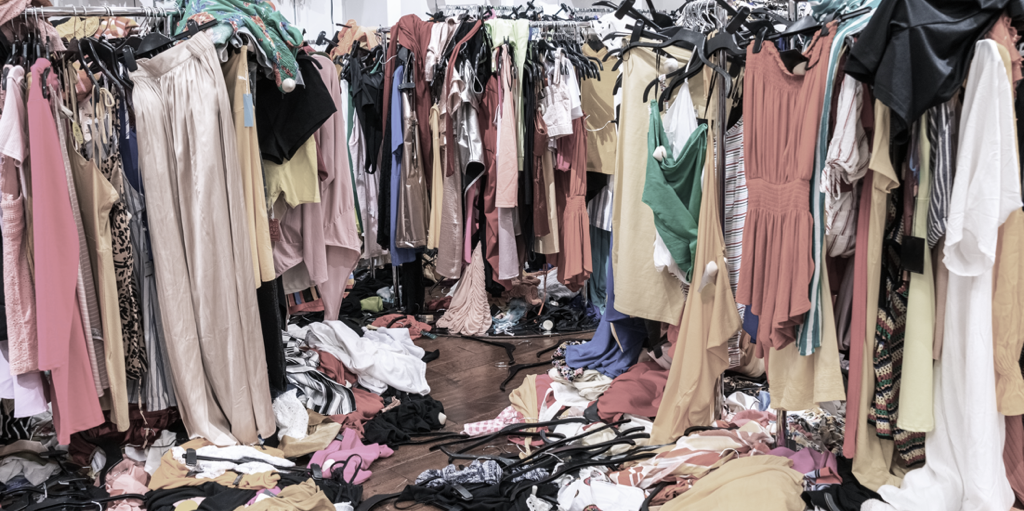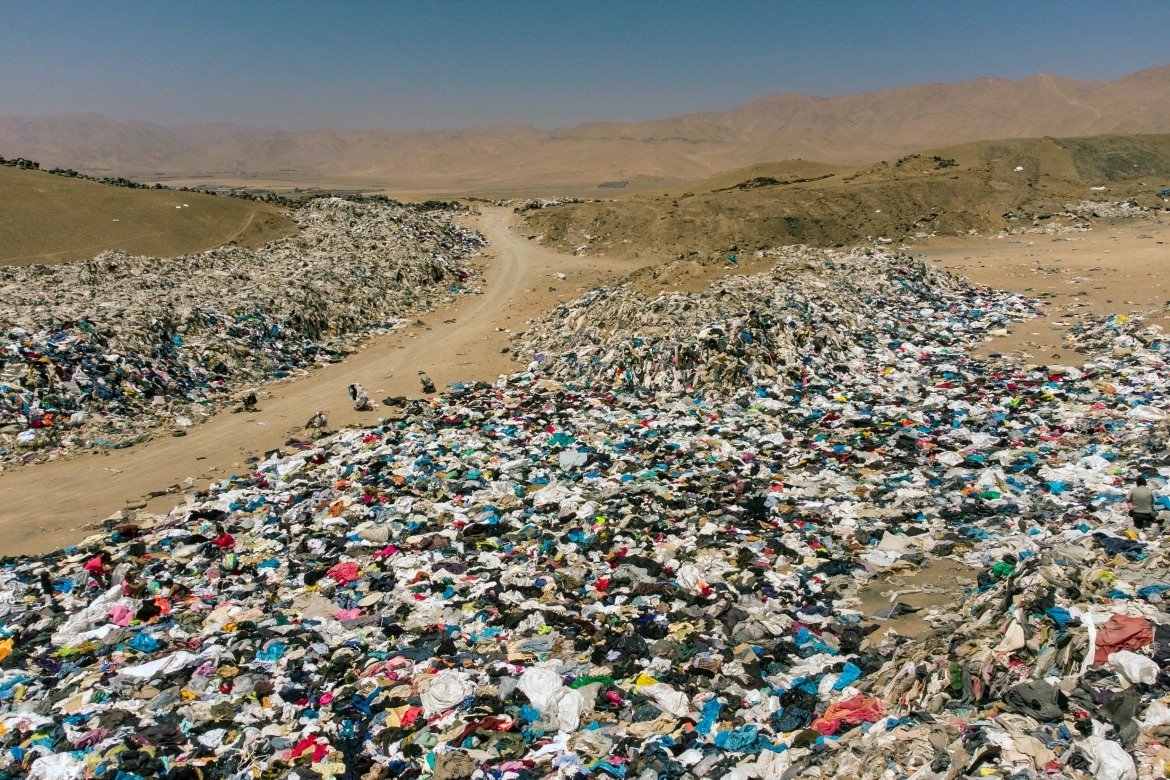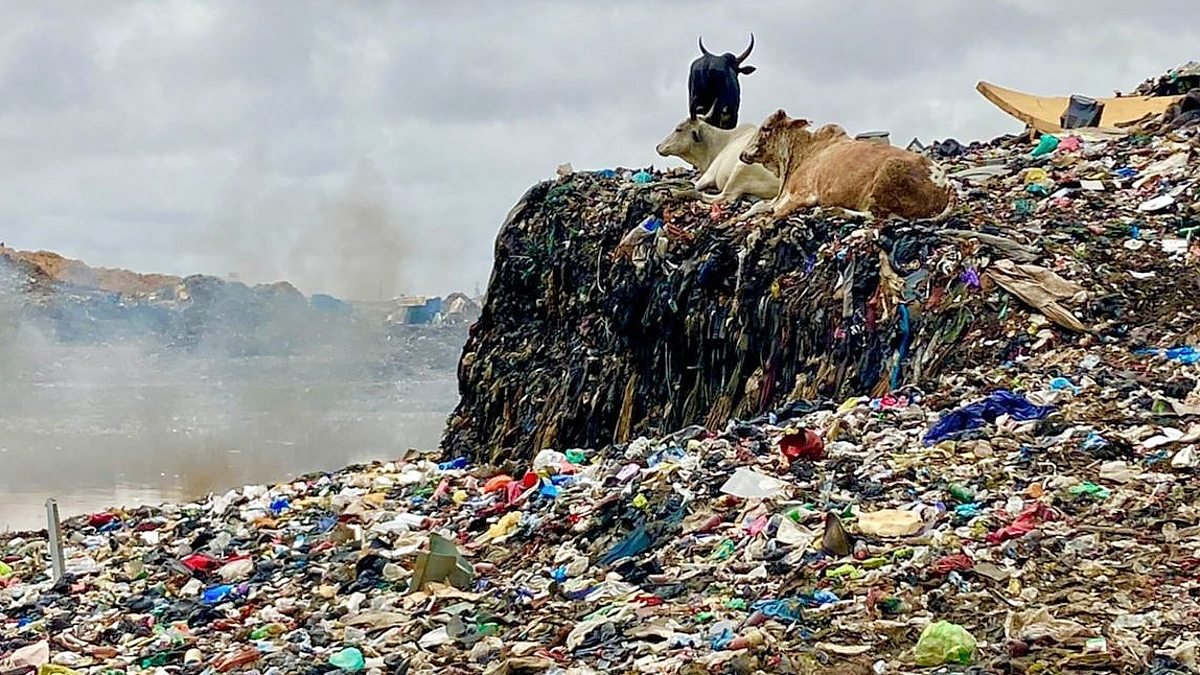Unsustainable consumption of fashion
The fast fashion model that exists today is inherently unsustainable. It manufactures insecurity for the sake of profit and produces cheap clothes that won’t last, destined for landfill.

Following the weather, there used to be four fashion seasons. Today, there are 52 micro-seasons.
This needless mass-consumption of clothing comes at a cost.
A reminder:
The best way to enjoy fashion sustainably is to buy less and care for your clothes, wearing them for as long as you can.
Fast facts on fast fashion:
Nine out of ten [PDF 3.5MB] garment workers in Bangladesh cannot afford enough food for themselves and their families because they are not paid fairly.
Global clothing production has doubled in the last 15 years, while on average, garments are being worn less and discarded faster.
Across the globe, we consume 400% more clothing than we did two decades ago.
Planned obsolescence is common in fast fashion, meaning clothes are designed to wear out or become unfashionable faster than ever.
It is common for brands to burn and destroy clothes that are not sold rather than give them away to ‘protect’ their brand.
Each year in Australia alone, 501 million kilograms of unwanted clothing ends up in landfill, and 94 million kilograms is exported to other countries.
On average, people only wear 50% of the clothes in their wardrobes.
Globally, the equivalent of a rubbish truck full of textiles and clothing is sent to landfill every second.
Fast fashion is an environmental and ethical crisis
The destructive dumping of fast fashion
Each year, tens of thousands of tons of unsold, unworn clothes are sent to a Chilean desert to slowly degrade, releasing methane emissions.
While deserts may appear desolate and empty, they are ecosystems that — like any other — host a wide array of biodiversity when healthy. The Atacama desert where fast fashion’s waste is dumped has been referred to as a ‘biodiversity hotspot’ in a peer-reviewed paper.
A similar story of destructive dumping plays out across many other parts of the globe.
Image: Martin Bernetti // AFP
Fashion dumping burdens poor communities
The Kantamanto markets in Accra, Ghana, sees an estimated 15 million garments flow through it each week. These clothes are mostly from fast fashion brands, thrown out or donated to op-shops by people largely in the West. Here, many of these clothes are skilfully refurbished by local people and businesses.
“Despite the best efforts of Kantamanto’s entrepreneurs, 40 percent of the clothing leaves the market as waste. Accra lacks the landfill space for this clothing waste, so much of it is burned in the open air, swept into the gutter from where it eventually makes its way to the sea, or dumped in informal settlements where Accra’s most vulnerable citizens live.”
This is another case of environmental racism in fashion, where wealthy white people, brands and systems export their problems to those a part of the Global Majority, and those who are poorer.
Image via BBC

To combat this crisis the fashion industry must:
Become circular, ensuring garments are recycled, biodegraded or repurposed rather than thrown out
Embrace radical degrowth, recognising the impossibility of a continually enlarging fashion industry on a finite planet.
The creation of a considered and circular fashion system which prioritises creativity, culture, individuality and total ethics is both more exciting, and critical to the future of our shared Earth.
Experts suggest the fashion industry must reduce its waste and use of resources by fourfold to exist within planetary boundaries — the limits to what we can take from the planet each year, before these resources cannot be replenished, resulting in degradation, pollution and ecological harm.
Just as infinite-growth capitalism and consumerism created factory farming, it’s also created fast fashion.
But we can all do our part to slow fashion down.
Wear what you have, and care for your clothes
Everyone can be involved in the slow fashion movement. If you have clothes that you wear and care for, you’re in!
Mending your clothes by darning, embroidering and patching them is a great way to ensure they last longer. Wash them carefully and only as needed in an environmentally friendly way. Hand or spot wash garments to save water, or try the eco-wash setting on your washing machine. Hang your clothes out to dry rather than using the dryer. You don’t even need to have a clothes line outside, just a drying rack.
Dress vintage and pre-loved before buying new
There are so many clothes that exist already, it makes sense to wear them.
Have a look at vintage and pre-loved clothing options online and in-store before buying something new.
There are plenty of animal-free clothes available through these avenues, so it’s perfectly possible to dress vegan and avoid wearing someone’s skin, which many of us feel uncomfortable with.
Support independent, local and total-ethics brands
Total ethics fashion prioritises life and wellbeing for all before profit and production. This means that total ethics fashion brands ensure liveable wages for those in their supply chain, use sustainable materials, and avoid all use of animal-derived materials.
Supporting independent makers and local business is a great way to support ethical innovation, community and fashionable creation.
Image: A.BCH, a Melbourne-based slow fashion label.
Fashion needs to be taken seriously:
When buying new clothes we need to think carefully, ask questions, and make sure we aren’t purchasing impulsively:
Anyone can encourage degrowth, circularity and total ethics in fashion — without buying a thing.
Everyone can help to change what fashion means and represents, whether through protest, community education, brand engagement and advocacy, by organising clothing swaps, and by getting creative.
Want to keep learning?
-

Microfibre pollution in fashion
Microfibres are tiny fibre fragments from garments that enter the environment through wastewater when we wash our clothes — so are synthetics all to blame?
-

Water scarcity and pollution
From crop production to fabric dyeing, the fashion industry is thirsty. However, less spoken about is the water footprint and pollution caused by animal materials.
-

Greenhouse gas emissions
As our climate continues to warm, many plant and animal species will not survive. More human homes will become unliveable because of rising temperatures and seas.







